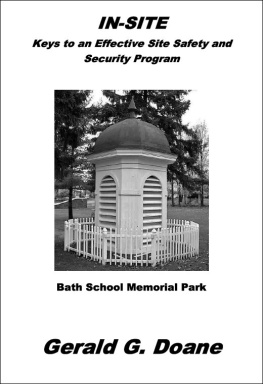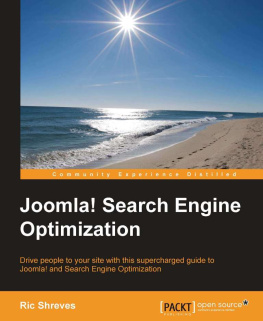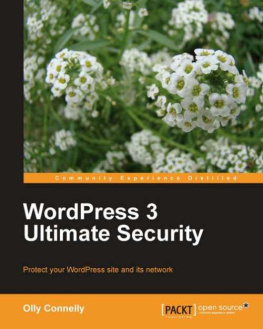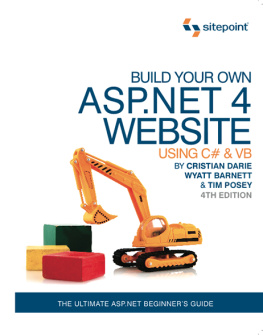Keys to an Effective Site Safety and Security Program
Author
Gerald G. Doane
Publisher
Code-4-Productions
Copyright 2018 by Gerald G. Doane
All rights reserved. No part of this book may be reproduced in any form or by any means without the prior written permission of the Author.
Cover photo courtesy of Wikipedia
ISBN: 978-1-7324820-2-9
eBook ISBN: 978-1-7324820-3-6
Produced in the United States of America
Safety and security at schools, places of employment, places of worship, businesses, nightclubs, venues, etc., all of which I call SITES, has been a topic in our consciousness in recent years because of the mass killings, most by gunfire, most by insiders, in every section of our country. Many, if not most of the killings were preventable, foreseeable risks ignored except for a very few who raised concerns about a threat they saw coming.
Mass killings at such sites is not a recent phenomenon. The deadliest of school killings, for example, occurred in Bath, Michigan on May 18, 1927 when Andrew Kehoe, a school board member, detonated explosives in and around his school house killing some 42 persons and wounding 43 others. Most killed, and wounded were children, several were school staff. In fact, there were prior behaviors by Kehoe indicating a threat to the school.
Safety and security are conditions and situations embedded in the presence or absence of hazards and threats. Can we remove all hazards and threats from a site? Probably not. But we can remove the most serious and the most egregious of catastrophic risks and manage the lesser ones reasonably well.
My mission in this text is to outline the six keys to managing an effective site safety and security program, a program based upon prevention, deterrence, and enforcement of policy.
I will be short and to the point. I could put lots of examples of policy statements and protective measures in this text, but I wont. I shall leave it to individual site management to flesh out the details. One area where I have provided a detailed example of policy is in Nine - Audit Questionnaire.
My purpose is to present an easy to understand process for managing a site safety and security program. I will leave out the bureaucratic dogma that we all dislike and most of us do not understand anyway.
In the end, it is all up to site leaders, site policy makers, and the people who carry out the policy, and that is all of us, to keep our sites safe and secure.
This book is not about the larger topic of societal gun control. We dilute our efforts at keeping sites safe and secure by focusing on societal gun control. Weapons policy is important, but it needs to be about weapons policy at the site.
Site safety and security is about one thing, effective management of hazards and threats.
I have taken the best I learned about safety and security management in my former role as Corporate Security Risk Manager at CrownZellerbach Corporation and coupled that experience with my long-term tenure in law enforcement.
I hope my work in producing this book helps the cause.
Access Control
A process of authorizing, granting, and recording the entrance to or contact with a protected person, place or thing.
Asset
A person, place and thing having value; possession; employee; visitor; customer; occupant; student; equipment; resource; property; financial.
Attending
Paying attention to; dealing with; waiting on; giving care to; providing care for; serving; monitoring on a regular basis; doing ones duty; attention to detail.
Auditing
Inspecting; reviewing systematically; fact-finding; comparing performance to standards; controlling.
Barrier
An obstacle preventing movement, access or communication; an enclosure; a structure; a circumstance; an obstruction.
Deterrence
Instilling doubt and fear in a threat or potential threat that the consequences of their actions or potential actions is failure; acting or operating in such a manner that a threat or potential threat believes there will be immediate and effective action to defeat its objectives.
Enforcing
Compelling the compliance of policy, procedure, rule, law, duty, or obligation; managers or administrators enforce organizational policy; prosecutors enforce state and federal laws.
Hazard
An object or condition that is harmful or potentially harmful; danger; a pothole (object); a lighting outage (condition).
Layering
Multiple layers increase the time and effort it takes to overcome any single protective measure; stacking; multiplying; compounding; force multiplying.
Managing
Operating within a planning, organizing, leading and controlling process.
Policy
Established decisions on important questions and problems; important decisions made in advance; laws; regulations; general orders.
Prevention
Action to stop something from occurring. Acting or operating in such a manner to identify, reduce or eliminate the occurrence of hazards or threats.
Procedure
Established ways of performing specific tasks; steps in carrying out a policy; duties outlined in law; steps in an operation.
Protecting
Keeping safe and secure from harm and injury; shielding persons, places or things; controlling access to persons, places, and things; monitoring, with an ability to respond, to keep persons, places, and things safe and secure from harm, loss, or injury.
Safety and Security
Conditions, situations relating to hazardous things or threatening persons.
Threat
Communications of an intent to inflict harm, damage or injury; a person or thing likely to cause damage or danger; threats are of a lesser category, reasoned to be of insignificant risk; or, of a serious category, reasoned to be of significant risk; or, of a major category, reasoned to be of a catastrophic risk.
The Managing Key
To be effective, a site safety and security program must have a comprehensive planning, organizing, leading and controlling process in place.
The Protecting Key
An effective site safety and security program can be viewed as having separate, but overlapping protective measures consisting of barriers, which include enclosures, access controls, and monitoring systems.
The Layering Key
Given time and effort most protective measures can be defeated or overcome. By creating layers, we increase the time and effort it takes for a threat to gain access to a protected person, place, or thing. Also, by creating layers of protection we make it more difficult to encounter hazards.
The Attending Key
Attending is a preventive maintenance concept adapted to site safety and security. The concept is that by attending to the small, seemingly insignificant outages, breakages, breaches, hazards or threats, significant savings can occur by preventing larger, costlier, or more harmful problems to develop.
The Enforcing Key
Important policy decisions must be enforced, otherwise a site safety and security program become meaningless. The overall enforcement of policy strategy is: Prevention first, deterrence second, and enforcement when reasonable and necessary.









